FSUK 2022 Winners
We did it! After many years of hard work and dedication, UGRacing is proud to be crowned overall winners at FSUK 2022. With exceptionally strong performances across all 3 of our FS, FSAI and Concept class entries, read all about how our best ever year at competition unfolded here!
UGR22 Car Launch Event
On Friday the 10th of June, UGR-IC22 and UGR-EV22 were unveiled for the first time at the University of Glasgow after a hard year of work and development from the team.
The Car Launch event was attended by over 100 people, with sponsors, family, and friends all excited to see the new vehicles, as well as hear a larger team update ahead of the journey to Silverstone to compete at Formula Student UK 2022. The team hosted everyone in the University building where there were speeches from our management alongside socialising before the big reveal!
Check out our Instagram for more car launch pictures!
FSUK 2021 Update
FSUK 2021 saw UGRacing secure its best ever results across the board! In a year like no other, the team collected multiple podiums, and even wins, in Design, Communications, Sprint and Acceleration events. Read more about our 2021 successes here.
FSUK 2019 Success
UGRacing return from Formula Student 2019 once again victorious! Personal bests in 7 out of 9 events offset a slight bittersweet ending to the weekend. Check out the full update on our events page.
Showcasing The Intake
Name: Peter Cochran
Subteam: Powertrain
Part: Engine Intake Manifold System
The maximum power that can be produced by a Formula Student vehicle is limited by imposing the use of an intake restrictor in the intake system. This restrictor then forces teams to design and manufacture a custom, purpose-built intake manifold.
UGR-19 features a Honda CBR600RR engine, the main aim of the intake system designed for a spark ignition engine like our own is to optimise the delivery of air from the atmosphere to the engine’s inlet ports. The mass of air entering the combustion chamber should be maximised, and the delivery of air must occur in a predictable manner, to give the driver confidence in the car and the throttle response.
The driving force in the system is the internal pressure generated by the suction stroke of the four stroke cycle. This negative pressure causes high repetitive loading on the component, and so the manifold must be strong enough to withstand this loading over large periods of time. The manifold can also become quite hot and will experience some exposure to fuel, therefore any chosen material must have excellent resistance to both heat and petrol. As with all parts of UGR19, the total weight of the system must be minimised with a defined factor of safety.
UGR-19 features a 3D printed intake system made with carbon filled nylon, this is the team’s first intake manifold to be 3D printed, and replaces the previous aluminium system. This switch results in an impressive weight reduction of 1.2kg in the intake system alone. This weight saving was helped by the ability to print the runners and plenum as one part, reducing the need for fasteners and seals.
The design was first evaluated using CFD so as to analyse the air flow through the plenum and into the runners, from this the design can be changed to optimise the flow rate. Many configurations were tested this way before the final design was settled on. The final design features a plenum of volume 1.5 litres with raised bellmouths and a domed base. The bellmouths are arranged in a square profile so as to help with the even distribution of air between cylinders. When the four bellmouths are arranged linearly, as in UGR18, it is often found that the outer two cylinders experience reduced air low relative to the inside two.
After the design was finalised in CFD, the structural aspects of the component can be considered using FEA, the component must be strong enough to hold a vacuum, but also be able to withstand the high pressures due to any engine backfires.
With the addition of this new intake manifold, and various other powertrain improvements, we have been able to boost the power output of the car, to a maximum of 72bhp at the wheels!
Testing at Kames
Today UGR-19 is running on her first racetrack: Kames Motorsport Circuit in East Ayrshire. The goal for the team is to get some testing miles on the car and for our drivers as well.
With the weather staying perfect throughout the session, we managed to practice skid-pad and obtain some telemetry data from the track so that adjustments to the car setup could be made for future testing and the upcoming FSUK competition!
Head over to our Instagram to watch some videos of the day!
Testing at University: 2
This evening we managed some more wet weather testing with UGR-19! Our Head of Powertrain, Peter, drove for the first time, and crowds of tourists stopped to cheer him on.
After the session, a very happy Peter said “The car is incredibly quick! Really nice to steer and control, very responsive. It’s a shame it rained as it was quite slippery, but that’s Scotland for you!”
Tomorrow we are heading to Kames Circuit for the first of three consecutive full-day sessions we have planned. Hopefully the rain holds up!
Testing at University: 1
Today we got UGR-19 out for her first test session at the back of the University! After a few wee electronic bugs and plenty of rain, our Head Engineer Kester was first in. Unfortunately, the session was red flagged by an especially large shower, but the team was still absolutely delighted to see the car run (as well as being pretty soggy).
Kester said “The engine is much smoother, the steering is much sharper, and it’s much quicker! Can’t wait to get back in…”
The team has an intensive testing schedule planned for UGR-19, so stay tuned for regular updates!
Showcasing the Uprights
A slightly different showcasing post today: it’s a video!
Our Head of Unsprung Mass, Cara Mackay, presented her Uprights design to the team earlier this year. Cara designed the Uprights as her final year project, and come September she will be working for Rolls Royce!
A massive thank you to Tannlin, who manufactured the Uprights for the team.
Find the video at: https://youtu.be/aVZhDW93zvk
Showcasing the Fuel Tank
Name: Manvydas Pletkus
Subteam: Powertrain
Part: Fuel Tank
The biggest challenge was to design a tank that fits in this year’s chassis well while still being big enough and abiding by all the rules. I tried a few different geometries and ran Star-CCM+ simulations until I found one that seemed to work best both packaging and sloshing wise.
The most notable improvements over the old tank are improved packaging and reduced weight. The tank now utilises space better in the chassis, leaving more room for other components and/or a smaller and lighter car. Additionally, the capacity of the fuel tank has been reduced since it has been made clear that the old tank was bigger than necessary. The wall thickness has also been significantly reduced, going from 3mm aluminium walls all around to 2mm external and 1mm internal walls, thus reducing the mass of the tank itself by more than a third.
I’d like to thank G&M Radiator for manufacturing the tank and helping us source materials, who have been very helpful and did an excellent job.
Showcasing the Suspension System
Name: Miguel Cuni Municio
Sub-team: Chassis & Dynamics
Part: Suspension System
Purpose of the part? The suspension’s job is ultimately to maximise the tyre contact patch at all times. Every other single purpose of the suspension system comes under this primary aim. The kinematics and dynamics of the suspension have to be designed and tuned in track to optimise grip levels and control tyre degradation. In addition stiffness is paramount for the suspension to work as intended with minimum compliance.
What are the specific features? The entire geometry had to be redesigned for the new 10” rims the team purchased this year. Not only that, the rear geometry has been optimised to remove the rear section of the chassis, bringing the rear bulkhead ahead of the rear axle, whilst improving the overall kinematics of the vehicle.
In addition, the vehicle size has been heavily reduced, there has been a 50mm cut in wheelbase and 50mm cut in both front and rear tracks. This change, alongside the great effort in weight reduction by the rest of the team, will contribute in further reducing the moment of inertia of the vehicle, making UGR-19 much more responsive than any of the cars that have been built in the past.
Further, the steering geometry has been thoroughly revised. There is a change from front steer to rear steer in order to increase Ackermann levels, reduce understeer and increase vehicle responsiveness.
One of the main focus for UGR-19 is weight saving, for that reason great effort has been taken in reducing mass within the suspension mechanism. Length of control arms has been reduced in order to save weight, also threaded inserts have a reduced size to further weight savings.
What testing has been carried out? At the moment we are testing the entire vehicle making sure everything works as intended. Therefore, we are elaborating a baseline set up our drivers feel comfortable driving with, so that we can compare test data with simulations, validate the design and develop a vehicle set up that will give us an advantage over our competitors!
What were the challenges to overcome? Designing a suspension system is a challenge in itself. There is an infinite number of methods and options and we need to choose only one. The greatest difficulty is devising a geometry that shapes the chassis in a way it perfectly blends the rest of the components and driver in one single package. Therefore, before placing a single points everything else has to be put together in order to achieve a truly synergetic design, creating harmony between subsystems in the car.
In addition to that, because of the smaller rims and overall smaller package fitting the control arms while improving the vehicle kinematics has been a rather difficult task. Countless hours have been spent simulation various set ups until the final iteration was achieved. Particularly troublesome has been the steering geometry. Due to the increase in Ackermann levels further clearance was required, making the front geometry of the vehicle pretty complex to design.
What are the improvements over last year? Due to the revised geometry and effort by the rest of the team to place every component as low as possible, the CoG has been reduced a 3%, which with revised suspension geometry helps reduce body roll by 4.5%.
In addition, there has been a 30% weight reduction in suspension mechanism mass thanks to the lower length of the suspension arms and smaller threaded inserts. Another reason to reduce the length of the control arms is to reduce compliance. For the same stress, a smaller link is going to experience a lower deflection since the strain is defined by displacement over original length.

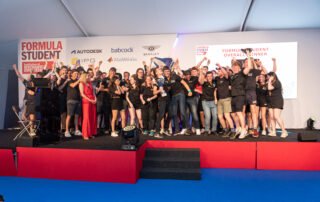
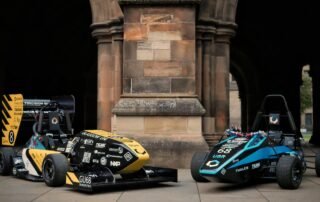



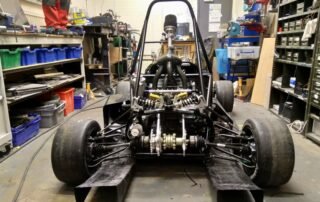







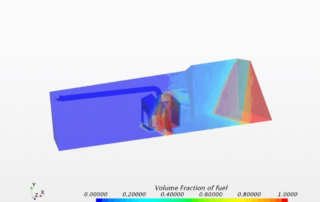
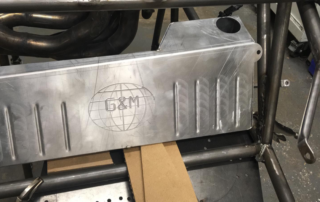
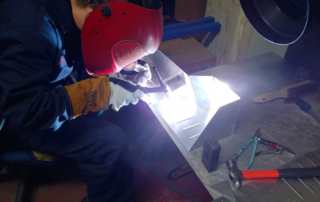


Social